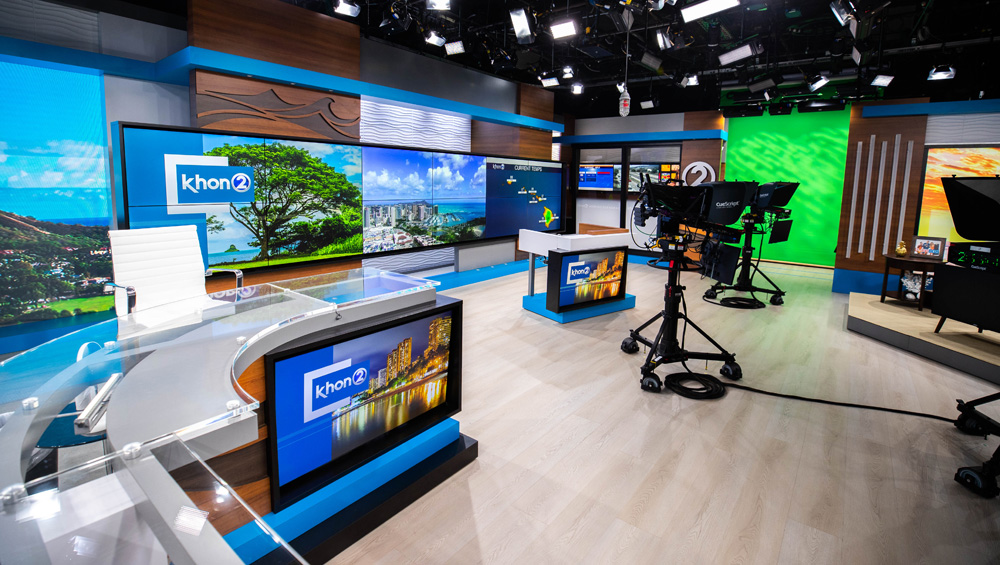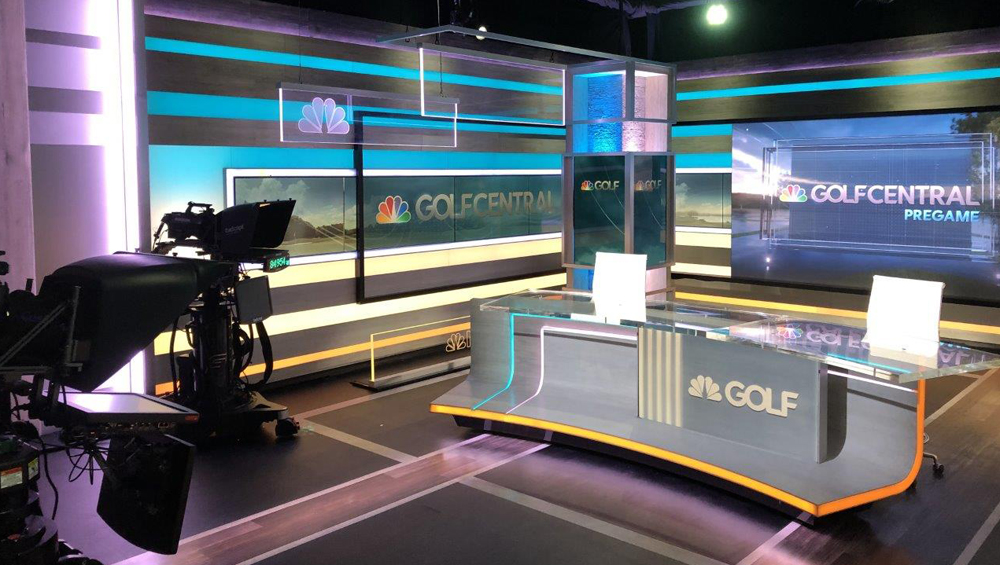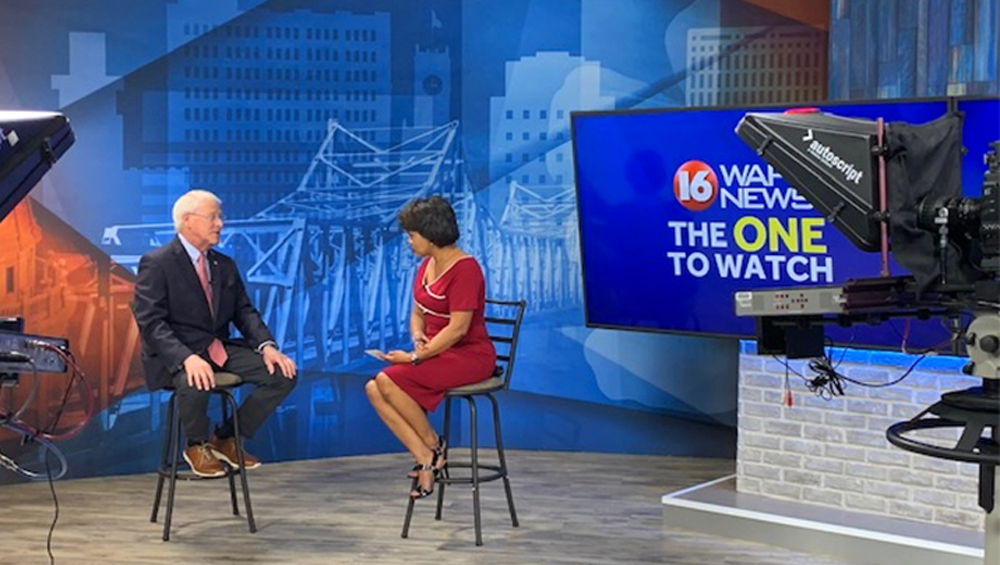
U.S. Newsrooms Warm On Video Walls, Cool On VR

American news studios are increasingly seeking out modern designs with video walls and warmer elements while overseas counterparts are selecting more virtual elements.
In the U.S., designs continue to revolve around video walls to enable the trend toward more video and graphics while also incorporating “personal expression” and “warm and inviting” elements. With ongoing improvements in augmented reality (AR) and virtual reality (VR) technology, both are seeing use in the U.S. for weather and sports, although news is slower to follow. VR is finding more acceptance with European and Asian viewers, so sets in those regions reflect that trend.
In-home setups are staying in place to serve as an option as the pandemic continues, although broadcasters have returned to their studios as much as possible. At the same time, corporate set design is a major growth area for studio designers, and these sets are making it possible for C-suite executives to make broadcast-quality appearances on television without having to travel to the station.
Mack McLaughlin, FX Design Group CEO/creative director, says video wall technology has improved — finer picture pitch, less moire and crisper graphics — while prices have dropped to the point that “fairly small markets” are able to purchase the technology.
And at the same time, broadcasters are learning how to serve up graphics on the video walls on a regular basis, he says.
“We probably will see a few studios that are almost 100% video” aside from a desk and a couple of other set pieces, McLaughlin says. “I think that’s the next thing you’ll see, video everywhere you look.”
FX designed the WGN set and installed it in Chicago last fall.
“They’re doing pretty cool stuff with that. It has several big video walls and is the closest to 100% video walls,” he says.
Getting Untied From The Desk
Kathy Skinski, general manager of broadcast and media for Planar, says light emitting diodes (LEDs) and video walls aren’t just part of the set but part of the “editorial equation.”
In the past, she says, the talent typically remained behind a desk. “The displays are playing a key role in the storytelling,” she says. “Now we see the talent interacting with the walls and moving around the studio.”
Kartik Dakshinamoorthy, VP for scenic design at Devlin Design Group , says he’s noticed broadcasters, such as the Tennis Channel, wanting to break out of the rectangular video wall mold, which can allow them to “do graphics in a very creative way.”
The Tennis Channel’s set includes video wall areas much taller than the rest of the 9-foot-high video wall in the studio.
He says he has also noticed that anchors seem less “tied to the desk” now than they were before the pandemic, making them willing to use “set design as a launch pad for new format ideas” instead of always shooting a show in the way it’s been shot for many years previously.
For example, he says, the desk may be a moveable unit, and “we have seen more and more stations use that flexibility.”
Skinski says LEDs make flexibility and customization possible without the need to change set pieces. For example, she says, an LED-driven set can switch seamlessly from a 6 o’clock newscast to an entertainment show in a moment by changing talent and “at the touch of a button.”
Planar has seen clients customize sets through creative elements, such as one morning show’s use of LED as a backsplash for a kitchen, she says. Some LEDs are curved, some are used as flooring.
“Anything you can come up with, the LEDs can make it happen,” she says. “Seventy percent of our stuff is customized.”
In fact, she says, LED and rendering engines can expand a small set to seem “like you’re in this huge environment” and “not confined by where the LED ends.”
In short, she says, a “gamut of technology” is available to the broadcast industry.
“We’re in the early years of what we can do with all the technology, but it’s definitely cool,” Skinski says.
Bucking The Trend Of Following Trends
The most refreshing change, Dakshinamoorthy says, has been seeing that a lot of stations aren’t worried about the latest trends.
“We’ve seen a lot more emphasis on their personal expression rather than going for a specific trend,” he says.
And that applies to the video walls as well, he adds.

A 137-inch Planar TVF Complete LED video wall serves as the focal point of Studio 7 at the NBC Sports International Broadcast Center in Stamford, Conn., home of the Golf Channel.
“If it’s a sports set, they want the set design or overall look to be connected to the game. If it’s news, they want it to be connected to the location where they are. They want us to capture the vibe of the location, the branding and values they have,” Dakshinamoorthy says. “They don’t want a set that could be anywhere.”
As Diane “DiFi” Fiolek, VP and creative services director at Devlin Design Group, puts it, the trend seems to be away from pitting themselves against the station across the street when it comes to technology.
“It’s maybe less about high-tech and more about high-touch these days,” she says. “It’s not just about having the biggest tech. It is really the thought about connecting with the community and the viewers.”
Bringing In Warmth
And part of that connection, Dakshinamoorthy adds, comes down to adding warmth to the set, such as through the inclusion of wood floors and accents.
“They don’t want the set to look cold with just video walls. They want a little bit of personality,” he says.
Fiolek says Devlin designed the set at WAPT Jackson, Miss., to convey a feeling of southern family style. The magnolia tree was something “they identified with” so Devlin “worked a magnolia into the news set.”

An interview in the Devlin Design Group-designed WAPT studio in Jackson, Miss.
One of the trends that André Durette, SVP/group design director at Jack Morton Worldwide, has noticed is the desire to use a mix of warm materials tied with modern sensibility to generate a modern feel that is “warm and inviting.”
As such, he says, technology “leads a big part of the design narrative” whether that technology is video walls, LED floors or touch screens.
The CBS news set in Washington, D.C., he says, is very modern, with the entire set wrapped in LEDs. “It has lots of flexibility. Even the platform is an LED floor.”
The CBS This Morning set has “moments of wood and natural brick” that are highlighted with “high-end technology that wraps the space and has the ability to change the space at the flick of a switch,” Durette says.
Whether the sets are in the U.S. or overseas, he says, technology is the centerpiece of every design.
But in the U.S. the sets are “more warm and inviting,” while overseas sets are “more austere,” he adds.
AR And VR Elements
Currently, Durette says, many weather and sports sets are incorporating AR elements.
“Almost every set I’ve designed has some sort of augmented piece because it helps tell the story, and it gives you a different perspective, which is great,” he says.
McLaughlin says a station may buy gear to incorporate AR into its broadcast, perhaps for weather or an election or Super Bowl set, and that could turn AR into the “Trojan horse” that will bring VR into more studios because the gear for AR is the same as that for VR.
On the other hand, he says, over the last two years, several FX clients with virtual sets switched back to real sets for several reasons. For starters, he says, VR is not yet standardized or intuitive enough that someone who was trained on how one system operates could easily work a different VR system.
There is also, he says, the fear that the system will go down and viewers will see a green screen. Broadcasters also don’t want viewers to “call them out for being fake” by using a green screen, he says. And finally, he says, another reason is financial.
“It’s not impressive when you walk into a studio and it’s a big green wall,” McLaughlin says. “You’re not going to lure advertisers with it. It’s a green wall, even if it’s cool technology, it’s not impressive to look at in person.”
Dakshinamoorthy says there hasn’t been a lot of interest in the U.S. for VR in news, although Devlin did design the 100% virtual Matter of Fact with Soledad O’Brien for Hearst.
As Fiolek puts it, “It’s still a tough sell in the U.S. Even though a lot of people think you press a button and virtual set pops out, there’s still a lot of design that has to be done to make it look real and not cartoonish.”
Jack Morton, on the other hand, is doing “a lot more work in virtual,” particularly overseas, Durette says.
While some designs offer a balance between a real set with an area for a green screen, others are wholly virtual, he says.
He predicts further embrace of virtual sets because the rendering technology has improved enough that the rendering “looks very real.”
During the pandemic, many stations were using virtual backgrounds because reporters and anchors were working from home, but not everyone chose to use them.
“We sent a lot of our clients a set as a background that they could throw up on a green screen,” McLaughlin says. Even so, he adds, some didn’t use them, preferring instead to say, “ ‘This is me — I’m real, I’m in my kitchen, or I’m in my den.’ ”
Corporate Client Growth
The main area for growth the studio designers have seen has been with corporate clients.
Professional corporate studios make it possible for “CEOs and CFOs to do snippets from those sets for CNBC or Fox Business or something like that,” McLaughlin says.
Others are using these new studios for internal communications, he says. “At some point, if not already, every major corporate entity will have one or more studios for different things.”
Fiolek says corporate clients are “getting far more sophisticated” with mega screens and multiple screens in the design, a move she attributes to being stuck at home relying on Zoom during the pandemic.
“Once they got back to business, they wanted to look as sophisticated as any news operation out there,” she says.
Kurt Heitmann, CEO of CP Communications and Red House Streaming Studios, says he is also seeing the trend toward corporate studios and multipurpose media rooms.
“Corporations are jumping into the bandwagon,” Heitmann says.
These facilities, such as the Visit Tampa Bay multipurpose media room, feature a lot of tech to support the corporation’s goals, he says.
“This is 10th one we’ve built in this area,” Heitmann says.
The Visit Tampa Bay CEO can do a hit on a local network simply by going to the VTB multipurpose media room, which can stream broadcast-quality content straight to the news station.
“They can do press events right from these studios,” Heitmann says. “This is the trend.”
































Comments (0)